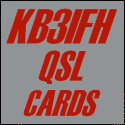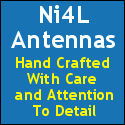Archive for the ‘Uncategorized’ Category
 Amateur Radio Weekly – Issue 329
Amateur Radio Weekly – Issue 329
A heavy sad heart
MFJ is ceasing its on-site production.
MFJ Enterprises
A QSL card revival for the 21st century
No printing involved. No mailing involved. No cost involved.
Ham Radio Outside the Box
Making an AllStarLink node with the URC
The following guide covers the steps to modify the Universal Radio Controller (URC) to use in an AllStarLink node.
G1LRO
QRadioLink
A GNU/Linux multimode (analog and digital) SDR (software defined radio) transceiver application using the Internet for radio to VOIP bridging (radio over IP), built on top of GNU radio.
QRadioLink
Radio frequency burns, flying a kite, and you
At half the signal’s wavelength, an antenna that long would capture plenty of energy from the nearby broadcast antenna.
Hackaday
DX-peditions collection
The California Historical Radio Society contributed this collection of DX-pedition material to the Digital Library of Amateur Radio and Communications.
DLARC
Trying a $15 70cm transceiver
Browsing Amazon I noticed a pair of 446MHz transceivers for $30 and I wondered what you get.
Marxy’s Musing on Technology
How to make emoijis in VarAC
Modify the VarAC.ini file.
PE4BAS
Excellent video series on RF amplifier design
A six part video series on how to design an HF 50 watt RF linear amplifier.
SolderSmoke
Video
Introduction to the Remote Radio Unit
Open source full duplex transceiver with RF isolators.
M17 Project
Watch electricity hit a fork in the road at half a billion frames per second
Measuring a wave of electricity traveling down a wire, and answer the question – how does electricity know where to go?
AlphaPhoenix
Get Amateur Radio Weekly in your inbox.
Sign-up here
 Amateur Radio Weekly – Issue 328
Amateur Radio Weekly – Issue 328
April 8, 2024 Solar Eclipse QSO Party first results
Over 52.7 million radio communications were observed over the continental United States.
HamSCI
The solar eclipse shifted time signals in the USA
On April 8, 2024, the frequency of WWV shifted.
spaceweather.com
We need better, more flexible user interfaces
Poorly documented user interfaces are a stumbling block to new Amateur Radio Operators.
Zero Retries
The art of articulation
The IC-705 has a two channel parametric equaliser built into the radio.
M0AWS
N1BSD: My Path to Amateur Extra as a DL Ham
The CEPT agreement only applies if you are there in person.
DK1MI
Getting started with HF digital modes (without breaking the bank)
What follows is a QRP digital modes kit that I’ve experimented with over the last year.
QRPer
This Apollo-era antenna still talks to Voyager 2
DSS-43 is the only antenna that can communicate with the probe.
IEEE Spectrum
AM radio gets House hearing
Draft Legislation to Preserve Americans’ Access to AM Radio.
RadioWorld
Going the extra mile
The Radio Operators who connect all 26.2 miles of the Boston Marathon.
The Huntington News
Amateur Radio saves family in Death Valley National Park
Without access to a cell network, the Ham called for help on the 10-meter band.
ARRL
Video
CW without Morse Code
T9 method for continuous wave communication. Easier than learning Morse Code.
Ham Radio University
Paperclip CW paddles
Demonstrating my paddles made from three jumbo paperclips, a block of wood, a 3.5mm stereo patch cable and four screws.
N1JI
Get Amateur Radio Weekly in your inbox.
Sign-up here
 Amateur Radio Weekly – Issue 327
Amateur Radio Weekly – Issue 327
Utah students use Ham Radio to connect with astronaut during eclipse
A Utah school district participated in an international program that helps students connect with astronauts using Amateur Radio.
Desert News
The Zombie Apocalypse
Exploring the feasibility for radio communication during an actual SHTF situation.
KE9V
USB-C charger for the MD-(UV)380/RT3(S)/GD-77
Using a 2S 2A USB-C charger PCB.
DK1MI
Simple guide to meteor scatter MSK144 contacts
If you are using FT-8 you are already half way there.
AB4BA
International Ham Radio events calendar
Add your event.
QSO Today
Lightning scatter at 144 MHz
Making use of the short scatter signals from lightning strikes.
TA1D
Building HamClock on an old Raspberry Pi
This is a great addition to any Ham shack.
M0AWS
Comparing prices of two 20AH LiFePO4 batteries: $60 vs. $265
The $60 battery delivers the goods.
AE5X
Crystal substitute using si5351
An inexpensive substitute for the 1647kHz LSB crystal.
Owen Duffy
Video
A novice’s guide to radio astronomy
SDR all the way.
Society of Amateur Radio Astronomers
DIY spark gap transmitter
Assembly and analysis of a DIY spark gap transmitter.
Baltic Lab
Get Amateur Radio Weekly in your inbox.
Sign-up here
 Amateur Radio Weekly – Issue 326
Amateur Radio Weekly – Issue 326
HamSCI solar eclipse events
Monday: Solar Eclipse QSO Party and Gladstone Signal Spotting Challenge.
HamSCI
ROC-HAM Solar Eclipse QSO Party
Monday: W2E special event takes place over HF.
ROC-HAM
How to DX the 2024 solar eclipse
DXing the mediumwaves promises to be an exciting event on April 8.
SWLing Post
LoRa APRS
Get involved using LoRa APRS on 433 MHz.
W0RMT
Performance of trees as radio antennas
Conventional whip antennas compared with the performance of Hybrid Electromagnetic Antenna Couplers (HEMAC) in conjunction with jungle trees as antennas.
United States Army Electronics Command
Ham mobile install–A few suggestions for dealing with noise issues
RF signals can emanate from your vehicle ignition system, fuel pump, fans, electric motors, onboard computers, and many other sources.
OnAllBands
Spain opens up the 40 MHz (8m) Amateur Radio band
Spain is the first big country to allow Radio Amateurs access to the 8m band.
EI7GL
Eavesdropping on security camera via unintentional RF emissions
Eavesdrop and wirelessly recover images from security cameras via RF unintentionally leaking from the camera electronics.
RTL-SDR
Video
Icom IC-7300 twins for DX hunting
The poor man’s 7610.
N5YIZ
What is the bandwidth of a CW signal?
Morse code signal is primarily dependent upon the keying speed (Words per minute) and the rise/fall time of the RF envelope.
W2AEW
Activating five new POTA parks in a day
Joe and I hit the road to activate five newly added Parks on the Air entities in Central Wisconsin.
KB8VBR
Get Amateur Radio Weekly in your inbox.
Sign-up here
 Amateur Radio Weekly – Issue 325
Amateur Radio Weekly – Issue 325
The most hackable handheld Ham Radio yet
The UV-K5 can be modded at the click of a mouse.
IEEE Spectrum
Designing a physical satellite tracking widget
Satellite tracking widget in a single small display.
ZR6TG
Whats going on with Morse Code?
CW seems to be on the rise within our ranks.
VE9KK
M17 project announces ‘repeater in a box’
M17 aims to provide a comprehensive FM/M17 repeater for remote sites or masts.
ARDC
Set up your own WIRES-X PDN
Operate a WIRES-X digital node station by directly connecting a compatible C4FM digital transceiver with a Windows PC.
Hamradio.ph
Ham Radio films
Films featuring Ham Radio.
G5DOC
HF APRS with JS8Call
How to configure JS8Call to report your location into the APRS network.
Lonneys Notebook
Welcome500 Network
A friendly, multi-mode digital Amateur Radio network.
Welcome500
HamTV returns to International Space Station
AMSAT expects the equipment to be operating in the coming weeks.
Amateur Radio Daily
Pirate Hunt 2024
Log as many pirate stations as possible between March 29th and April 1st.
Sisä-Suomen Radioaktiiviset
Video
I toured a Radio Shack
Video tour of one of the last Radio Shacks.
AA0Z
A cool APRS feature you probably don’t know about
APRS group messaging.
KM4ACK
Get Amateur Radio Weekly in your inbox.
Sign-up here
 Amateur Radio Weekly – Issue 324
Amateur Radio Weekly – Issue 324
Open HT surgery gives cheap transceiver all-band capabilities
Watch out, Baofeng; there’s a new kid on the cheap handy talkie market.
Hackaday
Ultimate Direwolf TNC installation guide
For Windows and Linux.
The Modern Ham
Operators criss-cross country airwaves
A nationwide event occurred recently involving tens of thousands of North Americans.
The Community News
FCC to require two factor authentication for CORES
Beginning March 29, 2024, multifactor authentication will be implemented.
ARRL
What became of Marlon Brando’s wonderland on the sea
Brando’s Tetiaroa Beach bungalow, circa 1979, is filled with his Ham Radio equipment.
LA Times
TinyGS: The Open Source Global Satellite Network
An open network of ground stations distributed around the world.
EI7GL
868Mhz ground plane vertical antenna
A neat little ground plane vertical antenna for the 868Mhz ISM band.
M0AWS
50 things you can do with a software defined radio
All you need is this simple USB dongle and an antenna kit.
blinry
This space physicist uses radios to study eclipses
Nathaniel Frissell works with Amateur Radio operators to learn more about our atmosphere.
ScienceNewsExplores
The GM3OXX Oxo Transmitter
The two-transistor transmitter.
AA7EE
Video
Go Kit Challenge 2024
Check out some AWESOME go kits.
Tank Radio
Flight over Glaciers of the Olympics
With 2M simplex operations.
W7NY
Get Amateur Radio Weekly in your inbox.
Sign-up here
 Amateur Radio Weekly – Issue 323
Amateur Radio Weekly – Issue 323
2024 ARRL Field Day Theme: Be Radio Active
The theme encourages Radio Amateurs to take advantage of the peak of Solar Cycle 25.
ARRL
Installing VARA on Debian 12 Linux
I thought it best to document it here, and maybe help another poor lost soul.
The Modern Ham
QLog
A cross-platform logging app with rig control, cluster, WSJT-X support, and more.
OK1MLG
Girl Scouts gear up to talk to International Space Station
Here’s how they’ll do it.
The Sacramento Bee
My ATU is soooo good, it will give a perfect match on anything
Even without an antenna connected.
owenduffy.net
CATS APRS alternative featured on Hackaday
CATS uses raw FSK rather than the inefficient AFSK used by APRS.
Hackaday
Low band VHF tests in Western Australia
The frequencies were 30.8761 MHz , 36.6073 MHz, 39.1467 MHz and 40.6864 MHz.
EI7GL
How I do it: A complete POTA activation from start to finish
Watch me, in real time, as I deploy an end fed half wave antenna, set up my station on a picnic table, and do a QRP (5 watt) POTA activation on the 15 meter band.
KB8VBR
Handmade QSLs from the 1930s
Hams would purchase post cards from the post office (only a penny each, including postage!) and created their own designs.
KB6NU
Source of major RFI identified
You may note that it is at least 5,9+10dB.
Johnson’s Techworld
APRS RX comparison
Anytone 878 vs Yaesu FT-5DR.
W0RMT
Video
Portable DIY adjustable 2m J-Pole
Peel and stick some metal tape on a strap, cut out a J-Pole pattern.
VA5MUD












